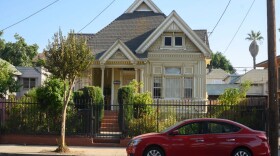An analysis of school bond borrowing by the Los Angeles Times reveals that 200 school and community college districts across the state have used risky, long-term capital appreciation bonds to finance school construction and maintenance spending.
That number includes 19 San Diego County Districts. This summer Voice of San Diego reported on the use of long-term capital appreciation bonds by the Poway Unified School District, which rely on dramatic increases in property values over periods of 30 to 40 years instead of predictions of more modest gains over 20 to 25 years that traditional bonds are based on.
However, the Santee School District has one of the most expensive instances of borrowing in the state when the projected total repayment amount is compared to the initial principal borrowed. For a bond issuance of $3,534,306, the district will pay a total of $58,559,818 over 40 years, or about $16.57 for each $1 borrowed. Poway's borrowing with the highest debt to principal ratio will cost the district about $9.35 for each dollar borrowed.
Rates like those are part of why Dan McAllister, San Diego County's treasurer and tax collector, is supporting tighter restrictions for capital appreciation bonds. He said to keep current tax rates lower, these bonds can rely on large balloon payments at the end of their lifespans.
“That responsibility will fall squarely on the shoulders of the taxpayers," he said. "And while it’s easy to promise voters that some of these bonds don’t have any impact on their taxes for the near term, the long term is pretty bleak."
The state legislature is expected to consider guidelines next year that include limiting repayment time to 25 years, debt to borrowing ratios to 4-to-1 and interest rates to 8 percent. They would also require that bonds be eligible for refinancing and limiting. Almost half of the San Diego County capital appreciation bonds wouldn’t have been allowed under the tighter repayment time and debt ratio restrictions.
McAllister said bonds that can meet these guidelines are financial tools school districts and other agencies can use responsibly.
School districts turned to capital appreciation bonds as housing values declined during the recession. Lower property values meant less tax revenue to borrow against using more conventional bonds. That left districts with the options of halting facilities projects, using the capital appreciation bonds, or asking voters to approve another tax, according to several districts' business managers.
Three of the county's school districts chose the last option this November and asked voters to reauthorize their school construction bonds. Voters in the Cajon Valley, South Bay Union and Dehesa School Districts approved a second property tax to cover the cost of existing bond programs. One of the main goals of reauthorization for these districts was avoiding capital appreciation bonds.
Many school districts turned to capital appreciation bonds to keep current tax rates stable. Scott Buxbaum, the Cajon Valley district business manager, said property owners in his district will pay more in the short term. But by approving another tax, they've shortened the repayment timeline of 50 to 60 years for the district's facilities program to 30 to 40 years. The hope, he said, is that the district will save years of interest payments in the long run.





